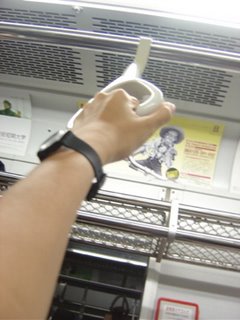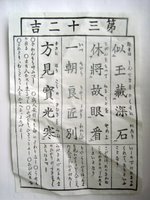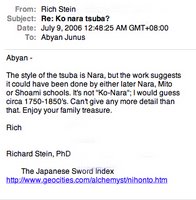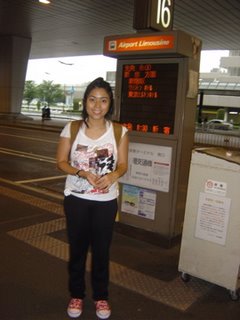 Sorry this post is late. I sent this email to some of my friends and family. For those I missed out, please have a read
Sorry this post is late. I sent this email to some of my friends and family. For those I missed out, please have a readTo my dearest family, friends and my mini-lover.,
Hello from Tokyo. What can I say about this city... It is overwhelming. As we drove in from the airport into the city, I was greeted by a concrete jungle, worse than New York (well from what i see in the movies). Rows and rows of multi storey buildings were intertwined with triple decker highways. If any of you have had a chance to play Tokyo Street Racer on Sega, they would understand me. I think the new Fast & Furious movie (Tokyo Ridge racer) would illustrate just what I mean.
 The Japanese favourite sport is baseball.
The Japanese favourite sport is baseball.I was already getting claustrophobic, just looking at the buildings. Well, we were dropped right at our hotel. Thank God I posted my bags straight to my dormitory, that really saved us a lot of trouble. You do not want to carry heavy luggage around in Tokyo. At the hotel, we just collapsed, fell asleep and woke up for a semi- expensive dinner. "Semi" meaning that you get a plate of pizza 7 inches wide and 2mm thick. It was like eating paper that costed RM25. Our coffee break at the hotel was RM 25 per coffee cup. A phone card to call Malaysia is RM30=average of 16-18 mins.
 Lots of traffic jam coming into the city
Lots of traffic jam coming into the cityNow I know really understand the true meaning of expensive = life in Tokyo. But sometimes, if you look hard enough, you can find a packet of biscuits, beautifully wrapped with individual wrapping (different designs for each) for ¥100= RM 3.20. Well, I guess Tokyo is a big challenge for the bargain hunter.
I will keep this email short. I plan to continue writing to you all through my blog. There, I can also upload pictures. Just note, my address:
http://www.abyjunus.blogspot.com
My camera is dead, and I cant seem to find an international adaptor anywhere. One reason a lovely Japanese man gave me was "This is Japan, we only get Japanese people buying our plugs.". Well... he obviously hasn't heard about FREE TRADE.
Anyway, today i did a recce of the Tokyo subway, braving it with my two senior but adventurous mom & dad. My sisters would be proud, although I did lose my temper a bit,when my mom started wanting to navigate us through a different way (especially when we had just walked the same street 30 mins ago, mind you I had a map!). Well Kak E, did this happen in Germany? I really sympathise. hehe... And pops, well he of course had to have his toilet breaks, and always wanting to break-off from the group. But in the end, I must say we survived. Amazingly, I only spoke Japanese the whole day!! I think Ive learnt about 10 new words per day since Ive been here. We managed to ask for directions, shop for shoes, look for cough medicine, check into the hotel, order our meals, browse through prepaid mobile phones (all in Japanese. phew! its slowly coming back.)
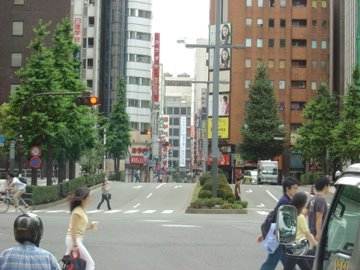 Not so busy in Shinjuku on a Saturday
Not so busy in Shinjuku on a SaturdayThe trains stations were ok. It's just a pity for you if you take the wrong exit. If you are in Tokyo, you must know what train line you want to get on. From there, you will have to buy tickets at the specific train line destination counter. Forget about asking help in English, again I had to speak Japanese. Surprisingly, there are not many information counters.
The dorm was great. I have a nice room in a lovely little neighbourhood. Very quite compared to the city. The busy city was getting to me by the end of today. I will write about my dorm another time, when I actually move in properly.. probably next week.
A funny thing happened near my school. There was a small hotel next door, so mom wanted to see how much it was (thinking we could move there). I walked in and asked the price and was surprised to find it so cheap. She was quite accomodating. Suddenly mom walked in all decked with her tudung and said hello to the lady. She started saying that the hotel wasnt appropriate for us and that we should go into the opposite inn. I kept asking why and she shook her head, until I heard laba's hoteru. (which means lover's hotel). So she was so embarrased that she personally took us directly to the inn next door. Now wonder the hotel was so dark! I thought it was cozy. hehe
I must say the Japanese are quite accommodating when you approach them, although there are also the few that live the real "i am a busy city folk, please don't disturb me" attitude.
Well, that's the end of today's story. It was very tiring and hectic. Sometimes I am amazed at what I got myself into. Tomorrow I will brave another day, this time a quick exam at school and battling with the local city council to get my "Alien" Registration Card.
I miss Malaysia and all of you very much. The loneliness hits the pits of my stomach when I sit in my room alone. Its that kind of feeling I used to get when I was returning to boarding school (my sisters will fully sympathise.. hehe).
My love to all my nieces, nephews and brother in laws.
Love heaps.
Aby
xoxox
 Well, a few weeks ago, I went on a school trip to watch the Kabuki Theatre. Off course, when I say school trip, Im sure you all imagine a big yellow bus, with lots of excited kids screaming and yelling. The Tokyo style of a school trip is to assemble at school and walk in big groups towards the station. Just another day commuting with the good citizens of Tokyo. When we got there, we went straight to our seats. There was a pre-amble before the show explaining the origins of Kabuki and its techniques. The storyline is so complex with twists and turns that purposely tries to throw you off the story (Even the average Japanese finds the kabuki hard to follow). Basically there is a bad guy that Rokusuke (the main hero) has to chase and during then he falls in love with a girl and saves a little boy from bandits. It was so difficult to follow, that I fell asleep throughout half of the show! It also didn't help that the men playing the shamisen were lulling me to sleep. On a good note, I must say the set design and costumes were great. Simple yet eye-catching. So, to wrap up my kooky kabuki experience, once is enough to last me a lifetime...
Well, a few weeks ago, I went on a school trip to watch the Kabuki Theatre. Off course, when I say school trip, Im sure you all imagine a big yellow bus, with lots of excited kids screaming and yelling. The Tokyo style of a school trip is to assemble at school and walk in big groups towards the station. Just another day commuting with the good citizens of Tokyo. When we got there, we went straight to our seats. There was a pre-amble before the show explaining the origins of Kabuki and its techniques. The storyline is so complex with twists and turns that purposely tries to throw you off the story (Even the average Japanese finds the kabuki hard to follow). Basically there is a bad guy that Rokusuke (the main hero) has to chase and during then he falls in love with a girl and saves a little boy from bandits. It was so difficult to follow, that I fell asleep throughout half of the show! It also didn't help that the men playing the shamisen were lulling me to sleep. On a good note, I must say the set design and costumes were great. Simple yet eye-catching. So, to wrap up my kooky kabuki experience, once is enough to last me a lifetime...



